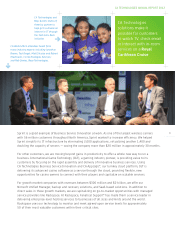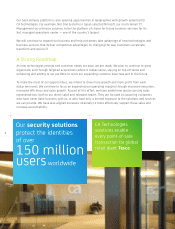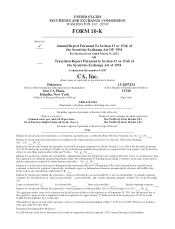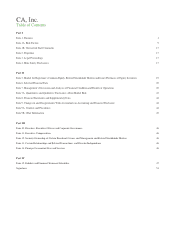Computer Associates 2012 Annual Report Download - page 15
Download and view the complete annual report
Please find page 15 of the 2012 Computer Associates annual report below. You can navigate through the pages in the report by either clicking on the pages listed below, or by using the keyword search tool below to find specific information within the annual report.
companies, retailers, educational organizations and health care institutions. These customers typically maintain IT infrastructures
across platforms, from physical to virtual and cloud, and from multiple vendors. These environments are complex and critical to our
customers’ operations. The majority of the Global Fortune 500 relies on CA Technologies to manage their complex IT environments.
As business demands increase and new technologies evolve, demands on IT continue to increase. Organizations expect more from
technology and many want to use IT to gain a competitive edge. This means companies are using IT to deliver products to market
faster, reach new customers and respond to changes in the competitive environment. To achieve their desired business outcomes and
gain business advantages, many organizations are improving the efficiency, mobility and availability of their IT resources and
applications by adopting next-generation technologies like virtualization and cloud computing and consuming IT as SaaS. They are
also extending their legacy physical environments to virtual and cloud environments. Virtualization lets users run multiple virtual
machines on each physical machine. Cloud computing is a shared pool of computing resources that can be accessed, configured and
used as needed. With SaaS, customers can obtain software on a subscription, “pay-as-you-go” model.
While these technologies can reduce operating costs tied to physical infrastructure, this evolution in computing is a transformative
opportunity that is also making IT environments more complex. Data centers are evolving to include mainframes, physical servers,
virtualized servers and private, public and hybrid (a combination of public and private) cloud environments.
We believe it is vital for companies to effectively accelerate, transform and secure all of their various computing environments, while
being able to deliver new services quickly based on their business needs. Our core strengths in IT management and security,
combined with our investments in innovative technologies, position us to serve a range of customers which we have divided into
three customer segments: (1) approximately 1,000 core Large Existing Enterprise customers with annual revenue in excess of
$2 billion (Large Existing Enterprises), which currently account for approximately 80% of our revenue; (2) enterprises with revenue
in excess of $2 billion that have not historically been significant customers of ours (Large New Enterprises), a customer segment
which we believe includes 4,500 potential new customers but where we intend to initially focus on approximately 1,000 of these
customers selected based on our current geographical and vertical strengths; and (3) approximately 7,000 enterprises with revenue
between $300 million and $2 billion and in fast growing geographies like Latin America and Asia (Growth Markets). We believe by
targeting these customer segments, we are more than doubling our total addressable market.
Our broad and deep portfolio of software solutions addresses customer needs across computing platforms. We deliver these solutions
on-premises or, for certain products, using SaaS.
We organize our offerings into our Mainframe Solutions, Enterprise Solutions and Services operating segments.
•Mainframe Solutions are designed for the mainframe platform, which runs many of our largest customers’ most important
applications. Our solutions help customers by addressing three major mainframe challenges: lowering costs, providing high
service levels by sustaining critical workforce skills and increasing agility to help deliver on business goals. We are growing and
extending our mainframe business by investing to drive innovation in key management disciplines across our broad portfolio of
products. Our CA Mainframe Chorus product solution continues to help customers control costs and increase mainframe
productivity and agility. We have extended these capabilities with CA Mainframe Chorus for DB2 Database Management, CA
Mainframe Chorus for Security and Compliance Management and CA Mainframe Chorus for Storage Management.
Our ongoing mainframe development is guided by customer needs, our approach to managing across platforms and our Next-
Generation Mainframe Management strategy, which offers management capabilities designed to appeal to the next generation of
mainframe staff, while offering productivity improvements to today’s mainframe experts.
•Enterprise Solutions include products and solutions that operate on non-mainframe platforms from physical to virtual, SaaS and
cloud. Our business outcome-based approach helps customers drive innovation by leveraging new technologies and the cloud to
meet business needs, mitigate risks and improve efficiency by managing complexity and reducing costs across their complex IT
environments. Our enterprise solutions can help customers achieve new levels of speed, innovation and performance by making
organizations more agile and by freeing up IT resources to invest in growth. Our solutions include:
•Service Assurance, where we are a leader in application performance management and infrastructure management. We enable
customers to transform IT management by linking applications, real users, transactions and services with the underlying IT
infrastructure. This provides a comprehensive, unified understanding of the real-time performance, risk and quality of business
services and end-users’ experience across physical, virtual and cloud environments, and the ability to predict quality of service
issues. Service assurance products include Nimsoft Unified Manager, CA NetQoS Performance Center, CA Application
Performance Management and CA Infrastructure Management. In addition, our August 2011 acquisition of Interactive TKO,
Inc. added service simulation solutions for developing applications in composite and cloud environments.
3
























